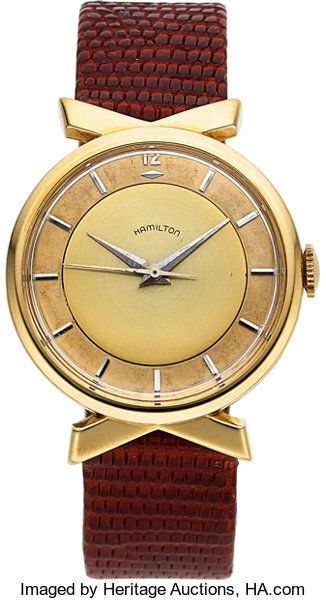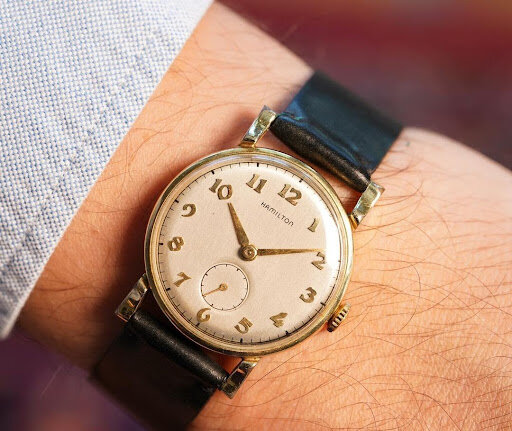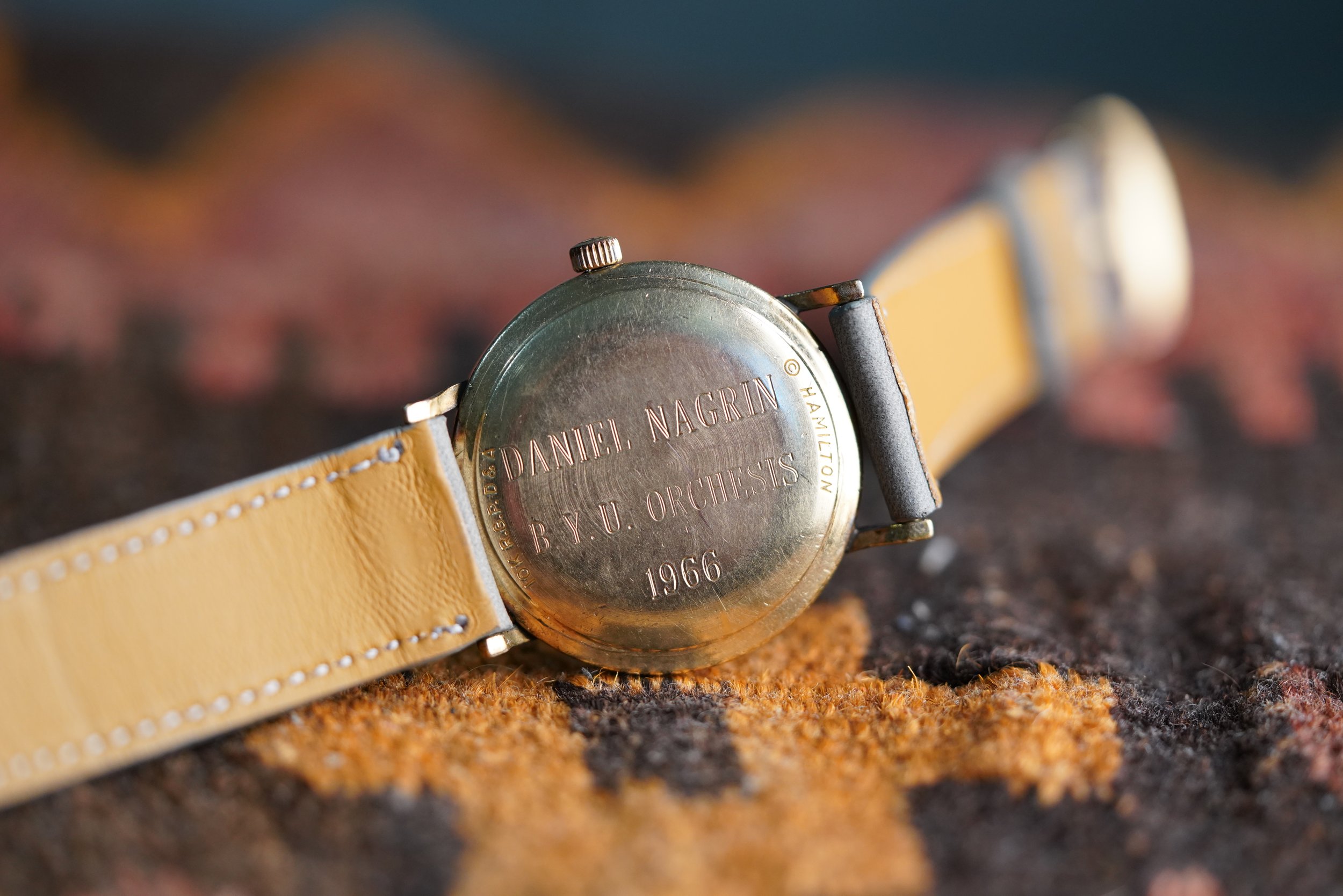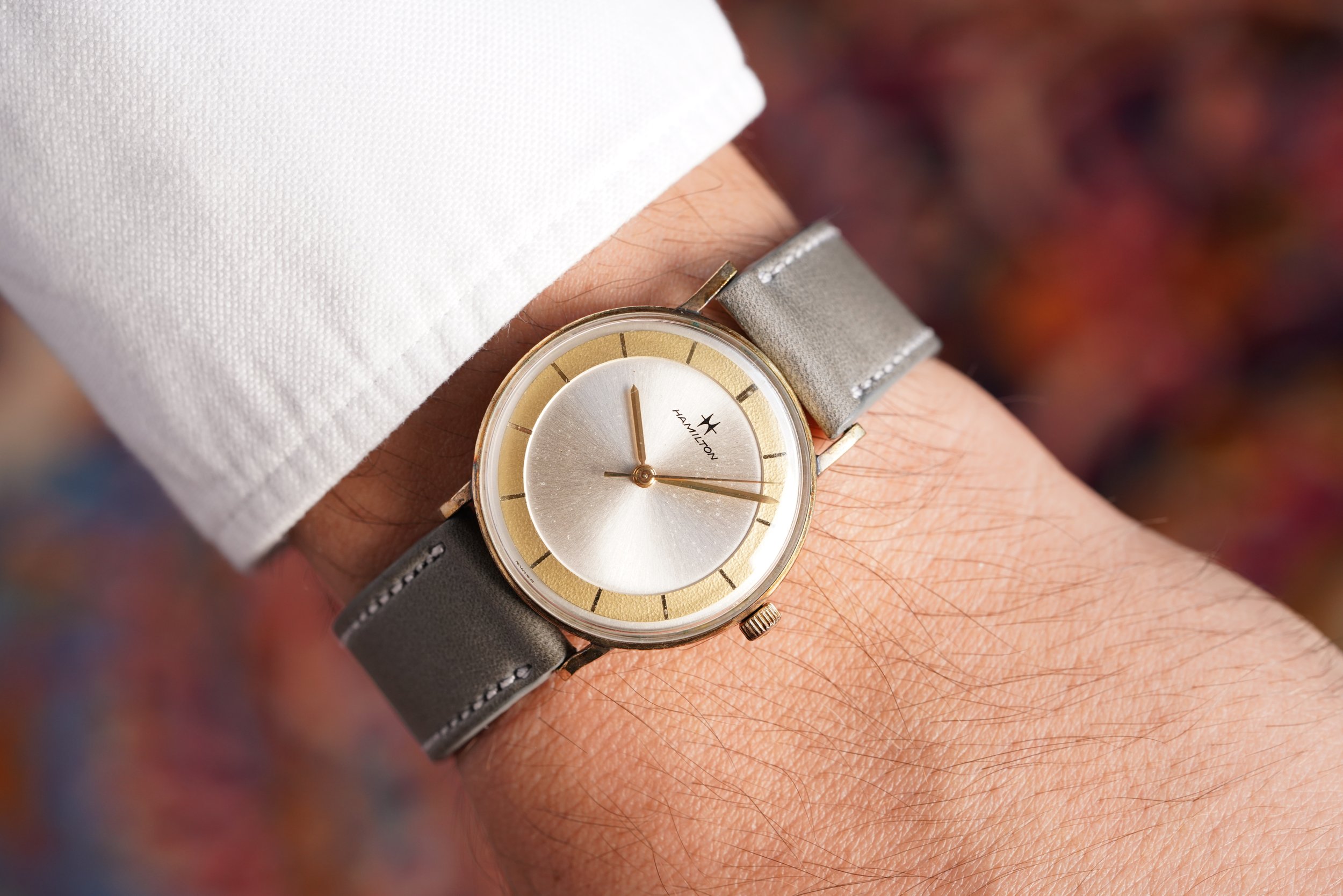
Found: Daniel Nagrin's Hamilton
A Pennsylvania Watch w/ Performing Arts Provenance. Yeah, Collecting Is Still Fun.
By Charlie Dunne
I’ve heard the sentiment a lot over recent years that this surge of watch “investment-collecting” has been ruining the passion of others in the watch scene. This narrative has been ever more consistent as the world’s 1% creep into the hobby looking to diversify their already established portfolio. With auction results rubbing collectors the wrong way, I continue to revert back to the same question: “Why not get excited about other watches?”
Now why am I prefacing all of this? Honestly, I would love to invite people into a different world of obsession. One with a ton of options, styles, and no waitlists. Most importantly, it’s a lane these deep pocket fat cats and oligarchs haven’t intruded upon (as for now). I’m referring to vintage Hamilton.
Vintage Hamilton is somewhat isolated from the so-called “blue chip brands” in that they don’t fit the traditional narrative of fine Swiss watchmaking. And while they don’t carry the same prestige that some gravitate towards in their nationality, they make up for in a rich spectrum of designs throughout the past century. Regarded as the highest standard of watchmaking in the United States, Hamilton watches would feature reliable American-made manual movements up until the 1960s. Soon after the tough chapter of Electric watches, it would become more cost effective for the manufacture to purchase Swiss movements (while still being assembled in the United States). Yet the overall interest is still somewhat of a niche genre held by discerning collectors entranced by the style, history, and ultimately, great value found within collecting Hamilton. Iconic models such as those designed by Richard Arbib, or the adorned art-deco Piping Rock, have seen the needle move on price. With all this in mind, there is a vast number of models that can be found at incredible deals.
It was during an uneventful eBay browsing session that I came across a watch that appeared to have some potential. While staring at the somewhat decent pictures offered in the listing, it met my initial confidence. Although I’m aware of the eBay Authentication Service, the overall watch trading/selling scene can be very muddy, particularly in that a great deal of vintage watches are frankensteined, optimized, etc without any disclosure. Yes, there are in fact bad actors behind such listings. However, many are also being traded not with malicious intent, but rather ignorance. While I’m fairly confident and well read on the brand, I appealed to the opinion of a few trusted friends (Tony, Eric, and Ricardo) to gauge their opinions.
I mentioned the cool casemaker’s initials and emphasized that the watch appeared to have provenance. Albeit it was not a household name, nor one I was familiar with for that matter. Nevertheless, I thought it was interesting and warranted a bit of banter. They agreed and I completely forgot about it until a few weeks later it arrived in working condition at my door by way of your friendly neighborhood watch dealer, Eric Wind. My interest was reinvigorated at the sight of the watch.

Daniel Nagrin was born in New York in May of 1917. Early into his college experience he discovered his passion and calling in life to become a performer. Initially pursuing a career in psychiatry, he shifted directions in the 1930s. Nagrin would study under influential choreographers and dancers such as Martha Graham, an internationally recognized pioneer of the American genre. He would become absorbed by the Jazz scene, frequenting Harlem’s Savoy Ballroom [1]. In 1943, Nagrin choreographed ‘Landscape with Three Figures: 1859’ based on abolitionist John Brown. The solo would be offered to American film and theatre producer Michael Todd two years later. However it would not come to fruition as it would be deemed “too politically sensitive” [2]. Critiques on American society would be a common theme in Nagrin’s performances. Confronting subjects such as racism, war, class and gender, his expression through dance distinguished him from his contemporaries as a leading figure in performance arts.
Performance of “Spanish Dance”. Video credit: Daniel Nagrin Theatre, Film & Dance Foundation.
Daniel Nagrin in 1979 performing “Jacaranda.” Credit: Lois Greenfied. Image credit: NYTimes
“When Mr. Nagrin is dealing with concrete realities, with live people in live situations, he can reduce their thinking and their backgrounds and their terse taut vocabulary of characteristic movement into exciting artist revelation. They are portraits that are truer than likenesses and they have a power and a bite that make them real stuff of the dance theatre.” - John Martin, New York Times
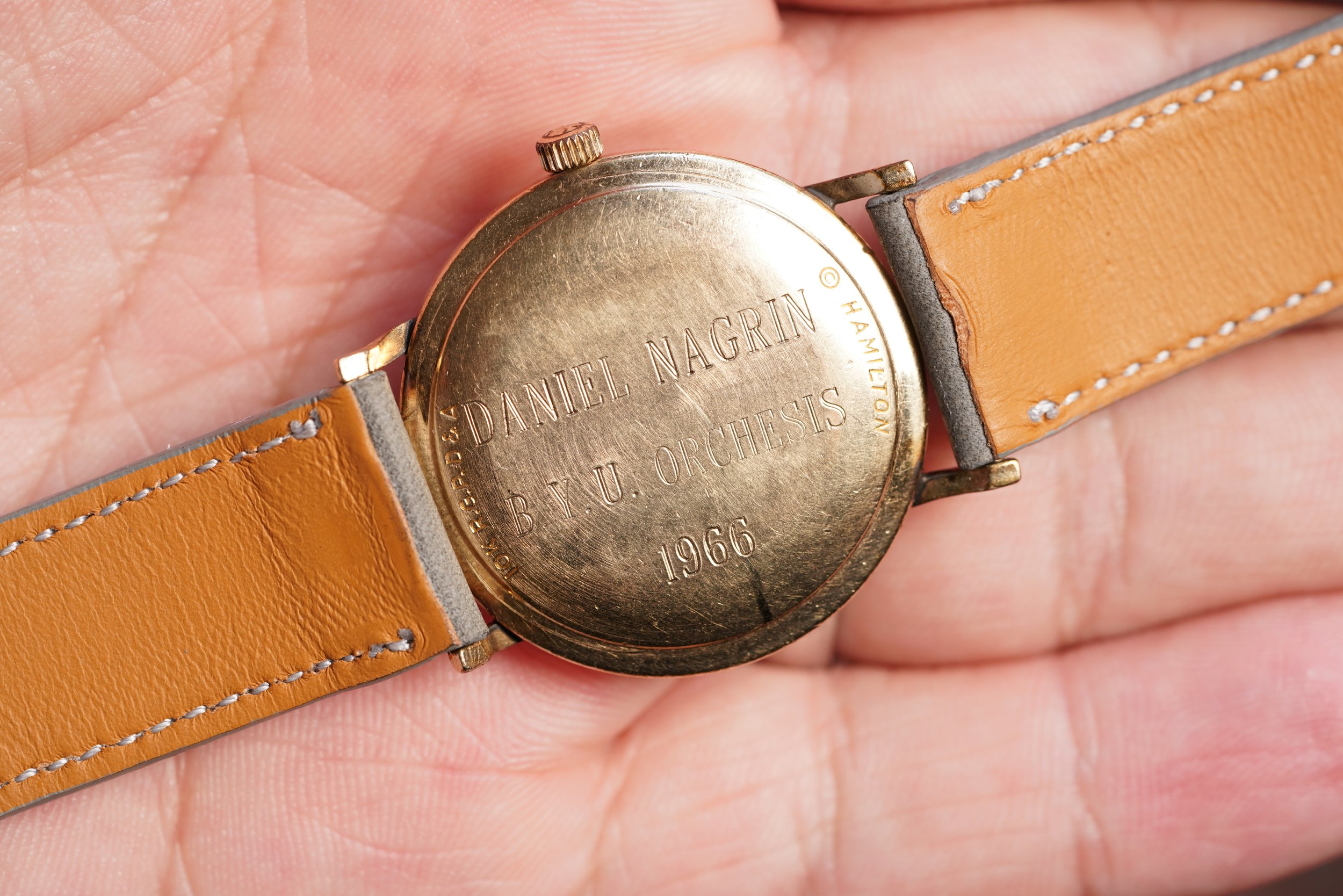
The Engraving
The caseback is prominently engraved with three lines between the casemaker and watchmaker stamps reading “DANIEL NAGRIN B.Y.U. ORCHESIS 1966”. B.Y.U. was relatively straightforward in deciphering as Brigham Young University, a Utah school founded in 1875 by Brigham Young, the president of The Church of Jesus Christ of Latter-day Saints. So the question presented itself, what happened in 1966 between the two parties?
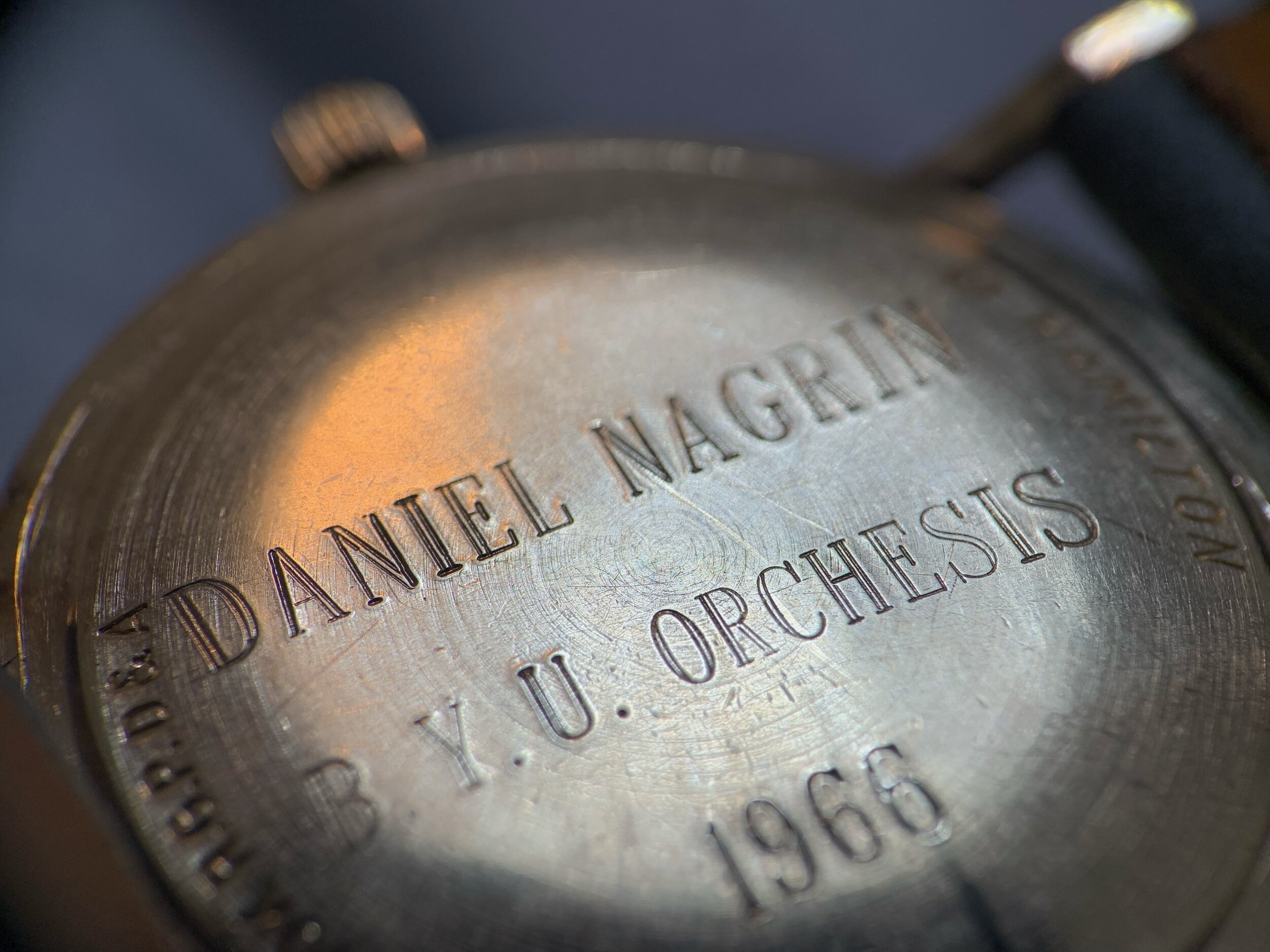

Performance at Brigham Young University
Soon after requesting the Visiting Concert Artists records from Brigham Young University, I was sent documents detailing Nagrin’s visit on March 26th, 1966 (ironically my birthday is March 26th). The artist put on two performances scheduled for 2p.m. and 8:15 p.m. which were open for both students and the community to attend. The concert included the performances “Path”, “Not me, but him”, “Spanish Dance” and “Indeterminate Figure”.
Brigham Young University’s Orchesis was established in 1952, providing the opportunity for graduating seniors to host an annual spring concert. Frank Hatch, a first year teacher and recent graduate from the university at the time was the director of the Orchesis during Nagrin’s visit [3]. This would mark the first visiting artist to perform at the university’s spring concert organized by the Orchesis national dance fraternity. Based on the engraving, it is clear that the student organization wanted to express their gratitude towards the performer for his visit.

Brigham Young University Lyceum Files - Visiting Concert Artists. Image credit: Brigham Young University.

The Daily Herald (Provo, Utah)20 Mar 1966, Sun Page 23
The Casemaker
Stamped onto the perimeter of the caseback are the initials D&A, identifying the New York based casemaker DiVincenzo & Arienti. The casemaker had done numerous styles for the likes of Rolex, LeCoultre and others. However, less frequently they provided cases for Hamilton. The stamped “10K R.G.P.” indicates the 10K rolled gold plating that has bonded to the surface of the watches’ base metal (likely steel).
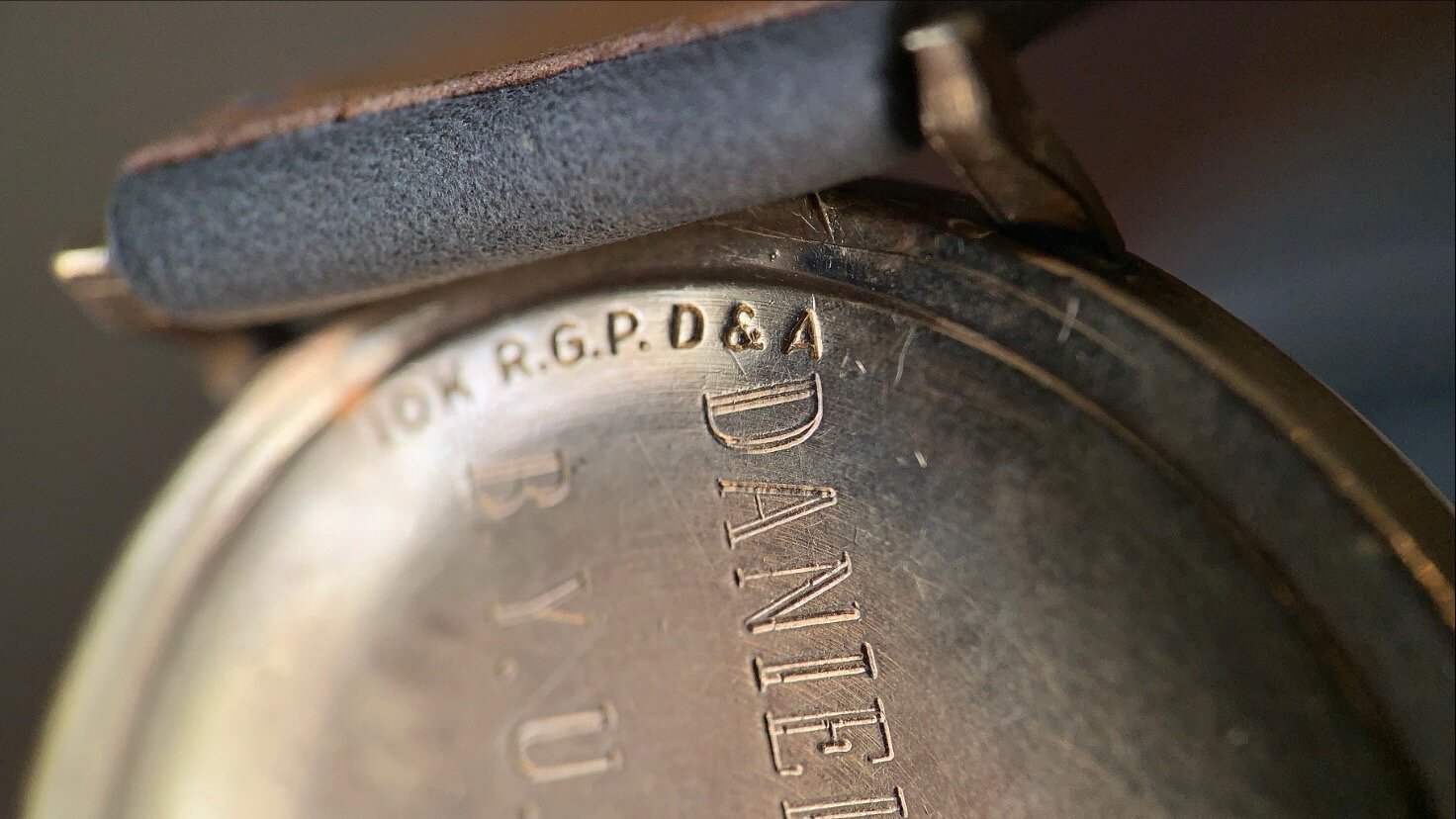
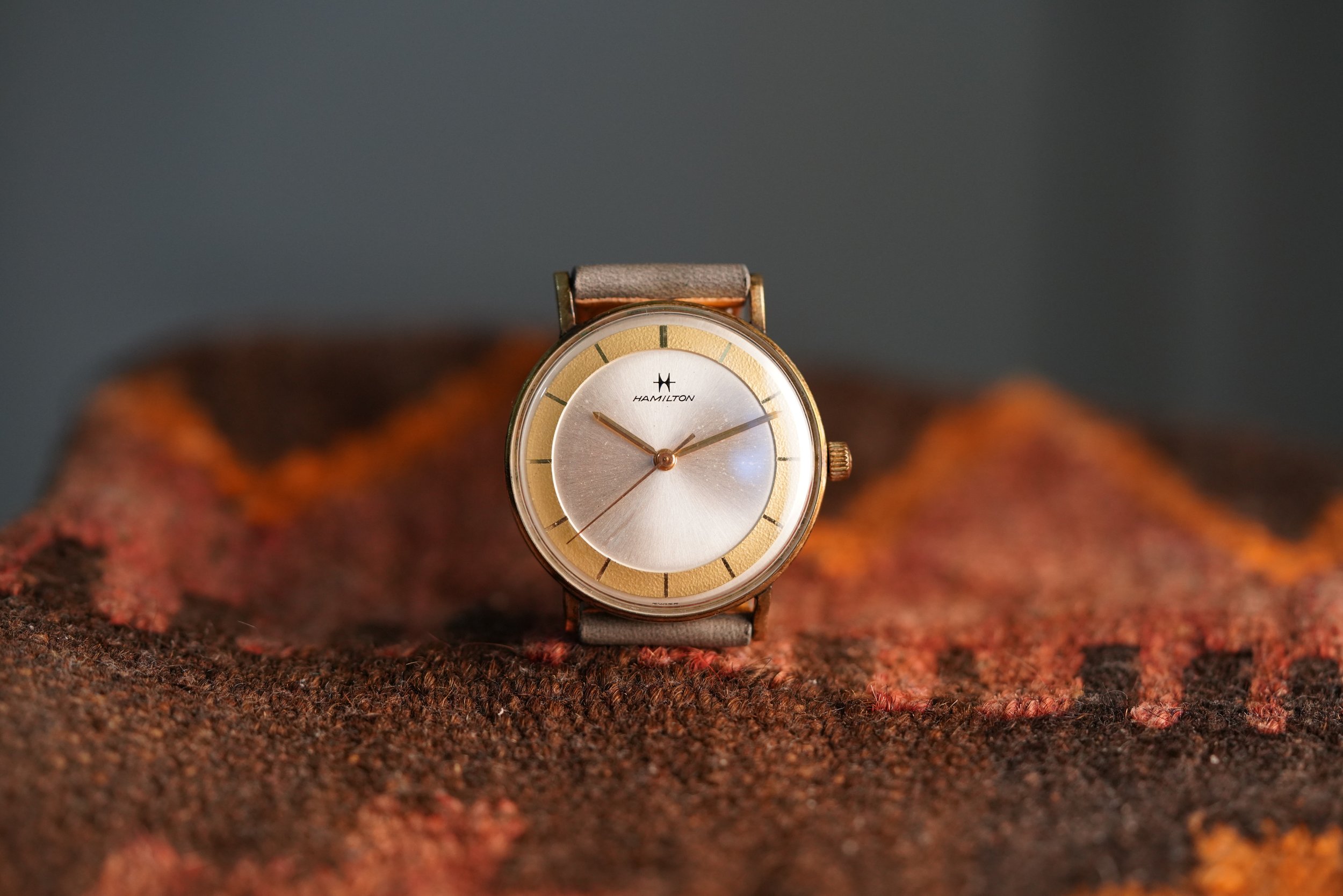
The Dial
Upon inspecting the dial in person, it was very clear that it was in original condition. Showing a pristine sunburst brush projecting from the center, the dial is quite stunning. The thick “H with a bar” logo that had been trademarked by the brand on January 7th, 1958 is expressed in perfect symmetry. The exterior of the dial is a galvanized gold-tone section with an almost sand-like texture divided between baton hour markers.
Understandably, these cases weren’t made to be water resistant, so it is easily susceptible to humidity. After a few instances of exiting the air conditioned car and home, it’s clear that the watch is one that should be worn with caution in the Florida humidity as almost instantly the crystal will fog up. Mindfulness is key in these situations to avoid any water touching the dial. Opening the crown, then flipping the watch face down is the best response in this scenario. I did manage to cautiously catch a few flicks while waiting for the humidity to exit the watch (because I like to live on the edge). Needless to say, this watch won’t be a daily watch, particularly in the summer season.
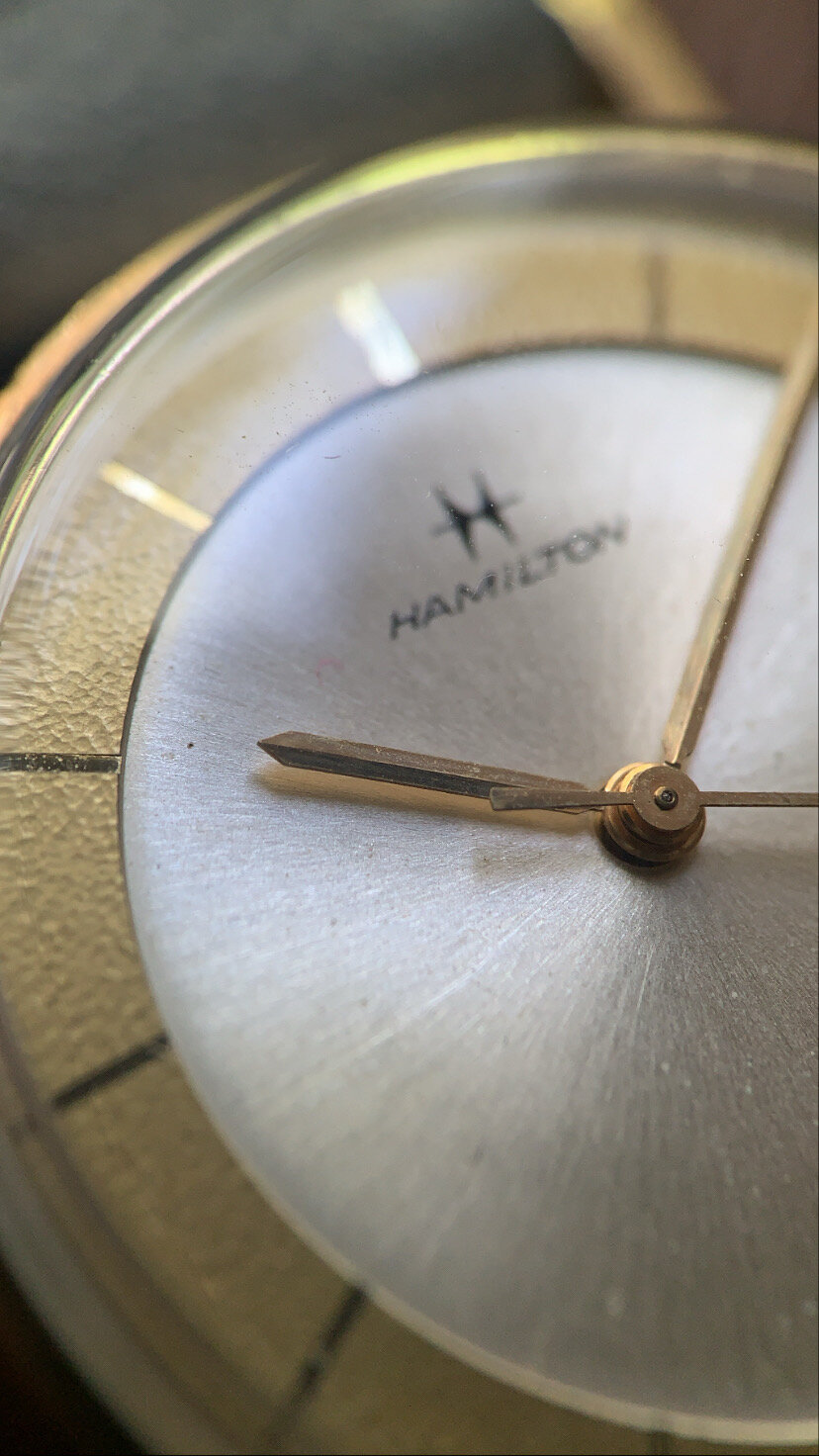

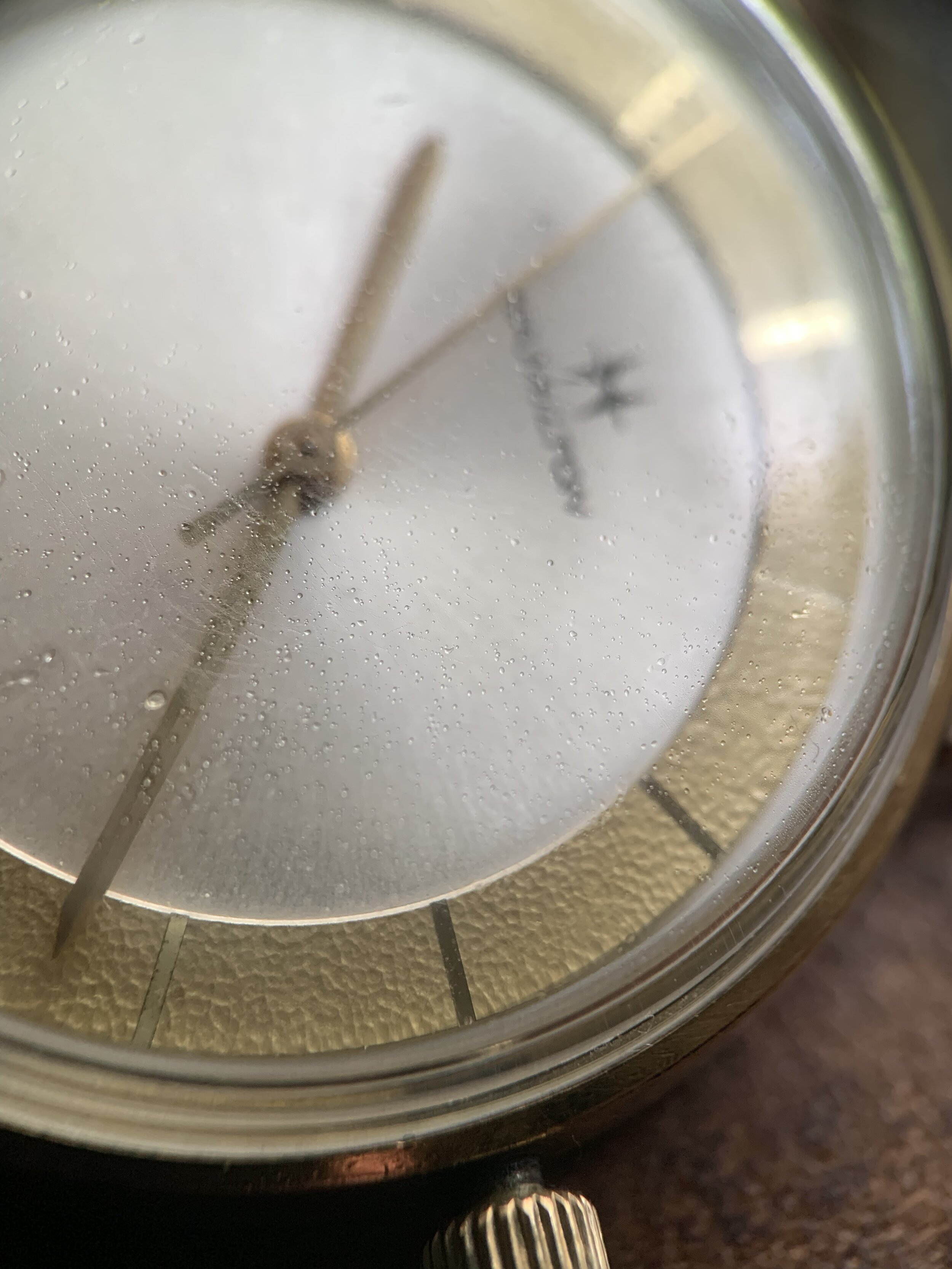


“Wearability” and Condition
As far as the “wearability”, the watch is a great size measuring in at around 32mm. While the lugs are skewed in each direction, leaving it to be solely applicable to this specific example, the lug-to-lug width comes in at roughly 36mm. While the lugs may detract from the preached rule of “condition over everything”, it supports the “as original as possible” rule that has been emphasized at length. How these rules are weighed against each other is quite interesting in that an argument could be made for preservation. The watch was found in a state that could have possibly occurred while on the wrist of the original owner. And while it would be difficult to confirm such a trivial detail, it is worth taking into consideration, and leaving it in the way it was found.
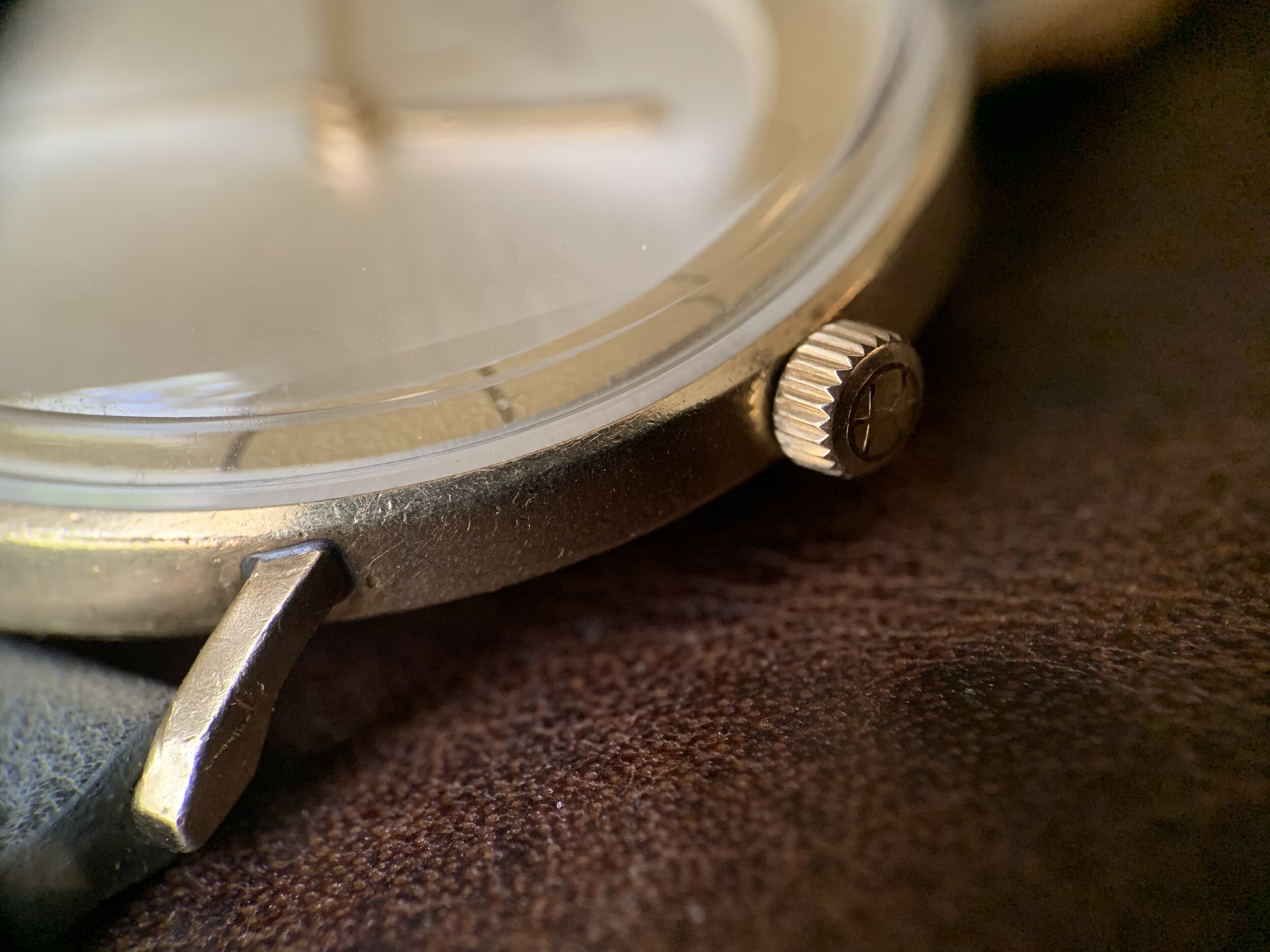
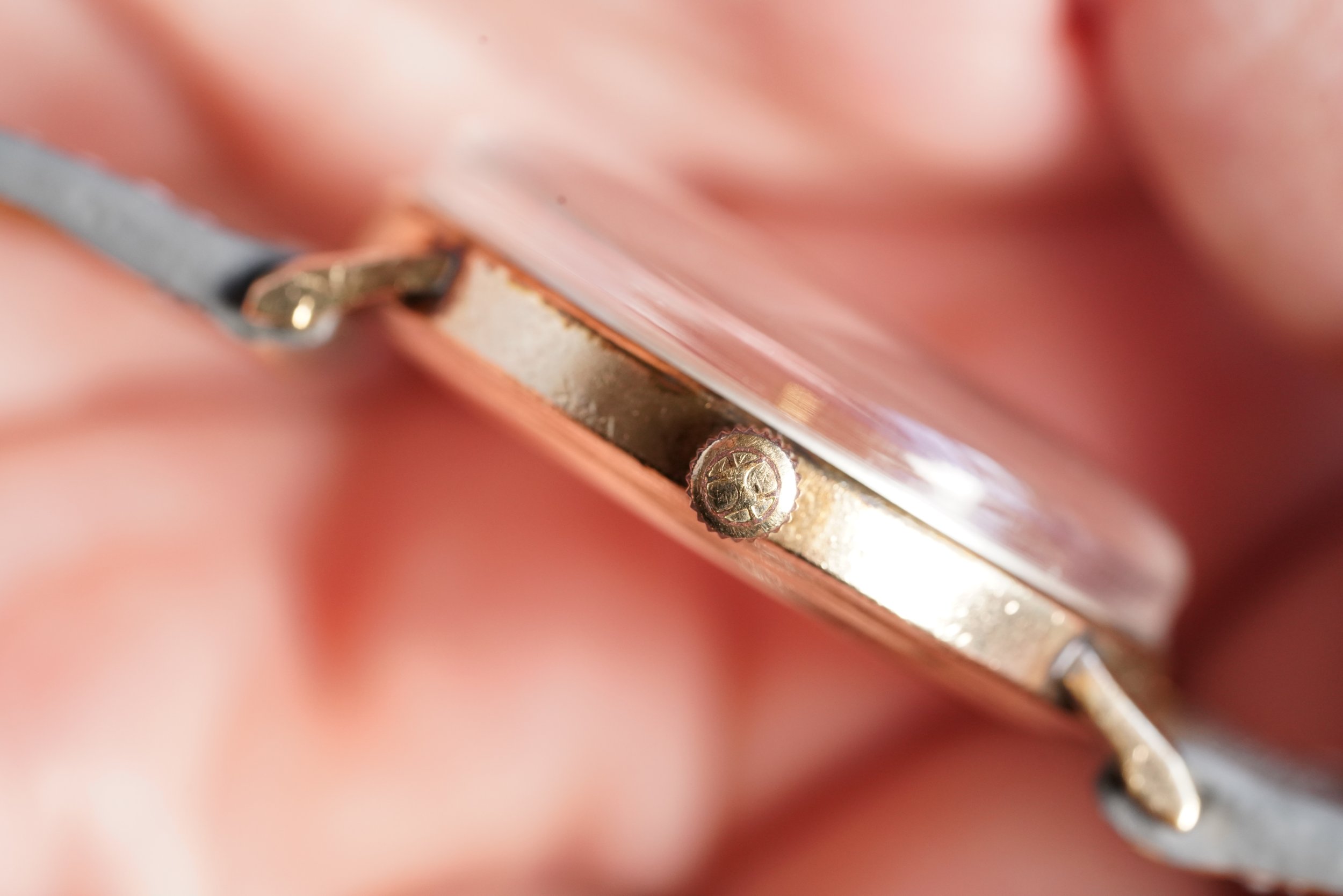


Searching for specifics
After skimming through a copy of Bruce Shawkey’s ‘Hamilton Wristwatches A Reference Guide’, as well as ‘Hamilton Wristwatches: A Collector’s Guide’ by René Rondeau, I was unable to locate the exact watch. At this point, there were examples featuring similar cases, and close dial designs, yet I couldn’t put a model name to it. And while it was clear upon close inspection that the case and dial were original, I was left on the fence as to whether the dial was born with the watch or perhaps the disheartening possibility of it being swapped at some point in the past. It was a few days later that I would look into the models Yeoman II and Sea-Guard. Both featured the exterior ringed dials, straight lugs, and importantly corresponded with a “Swiss” movement/dial. However, the details such as dauphine hands, hour markers, and crosshair dials left me feeling that this wasn’t adding up.
Credit: ‘Hamilton Wristwatches A Reference Guide’ by Bruce Shawkey.
If you are a Hamilton fan, there are a handful of key authorities in print that you’re aware of. Such experts include the aforementioned authors René Rondeau and Bruce Shawkey. Names such as Donald Sauers, author of ‘Time for America: Hamilton Watch 1892 - 1992’, as well as the late NAWCC vet Roy Ehrhardt who self-published several volumes on price guides before the world had the online resources we cherish today. Due to the fact I take a great deal of pride in learning from watch literature and primary source material, these were the resources I thought would provide the answer immediately.
I reached out to Hamilton Electric Watch Specialist Jarett Harkness of Unwind In Time whom I had first crossed paths with during the NAWCC Florida Regional of 2017 (or perhaps 2018). Upon touching base with him about the recent acquisition, he had mentioned that the watch was foreign to him as well and that it was one that hadn’t passed through his inventory yet.
M-Series Hamiltons
I later arrived at a 2014 article titled 1960 "Sea Something" on Hamilton Chronicles which featured the same model. It appeared that the author, Dan Keefe, was initially running into the same struggle defining the watch, alluding to similar yet different examples from the Thin-o-matic line and the Automatic K-419. At the bottom of the article I read “If you think you know what it is or if you have the same watch, please let me know”. Before I was able reach out and commiserate over the mystery I noticed a key development in the hunt.
“UPDATE - Turns out this is one of [the] Hamilton M-series watches and specifically it's a M-79-1 that came out in 1961.
M-series watches were produced from 1961 through 1967. The first number (79) was it's retail price and the dash number (1) means it was the first model at that price point. So there's likely a M-79-2 and a M-79-3 in later years.”
Eager to learn where this insight was found, I reached out to Keefe via instagram. He clarified that “M series (and F series) were uncatalogued models presumably marketed through a single large retailer starting in 1961 and going through 1967. Outside of 1964, M series models weren’t shown in Hamilton catalogs.” He informed me that I could in fact find the watch within the spiral bound booklet ‘Hamilton Watch Co. Production Figures with Grade and Serial Numbers Identification and Price Guide’ by Roy Erhardt (which I had neglected to open until that point). With this new information, I ended up finding other examples that validate the dial layout belonging to the watch.
Winding Up
With such diversity in the vintage Hamilton collections over the years, coupled with the extremely inviting prices, it is perplexing how the brand is still such a well kept secret. And while it may require some studying to evaluate the right models to go after, the foundation of resources is quite readily available. Hopefully with the example of an interesting acquisition for less than $150, the seed of interest will grow in those looking for a bargain watch they can be proud of. Lord knows there are plenty waiting to be found.
Throughout the search of this watches’ story, I found myself coming back to the important notion of “Always Read The Caseback”. Quite literally, history is erased due to the desire to have a pristine looking watch. I feel it is important to take a hard stance against polishing or laser welding these elements away. There was an intention behind them that should remain with the watches. To remove these only distances the watch from its past life, and diminishes what was once a significant part of its story.
For those that are fans of Hamilton and watch literature in general, I felt inclined to share Bruce Shawkey’s Go Fund Me. If you find yourself a bit up this month and don’t have any watches in your scope, I’m sure he would greatly appreciate any assistance monetarily (in addition to well wishes or prayers).
Citation Information
Register of the Records of the Public Communications Department, 1951-1979, (3) L. Tom Perry Special Collections Library, (4) Harold B. Lee
Literature:
‘Hamilton Wristwatches: A Collector’s Guide’ by René Rondeau
‘The Watch Of The Future’ by René Rondeau
Hamilton Wristwatches A Reference Guide’ by Bruce Shawkey
“Hamilton Watch Co. Production Figures with Grade and Serial Numbers Identification and Price Guide’ by Roy Erhardt.
‘Time for America: Hamilton Watch 1892 - 1992’ by Donald Sauers
‘Retro Watches: The Modern Collectors' Guide’ by Mitch Greenblatt (various brands)
